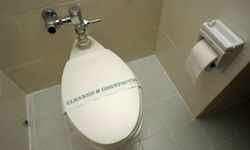It's the one spot in every home that all members of the family use on a regular basis, from California to Dubai. Culture, custom, habit and convenience all dictate a society's notion of what defines a "toilet," even though this humble household item is often taken for granted. We do what we do where we do it, with little ado, due to the toilet's unassuming quality in our lives. It's hardly any wonder, then, that so many folks are startled when encountering their first foreign toilet. Chances are, you might be surprised at some of the international toilets, both public and privately maintained, that the world has to offer a weary traveler.
Across the globe, the toilet has evolved within sets of specific cultural traditions. Since each country has a different concept of hygiene, access to disposable paper and water availability, our body's most natural functions have been dealt with in a variety of ways.
Advertisement
Despite complaints about airline bathrooms, plan an international excursion and you may find that the airplane toilet was the last vestige of your hometown bathroom expectations. But you'll also find that the world offers a myriad of ways for one to "get down to business." Forewarned is forearmed, and so, world travelers, brace yourselves for a tour of international toilets.






